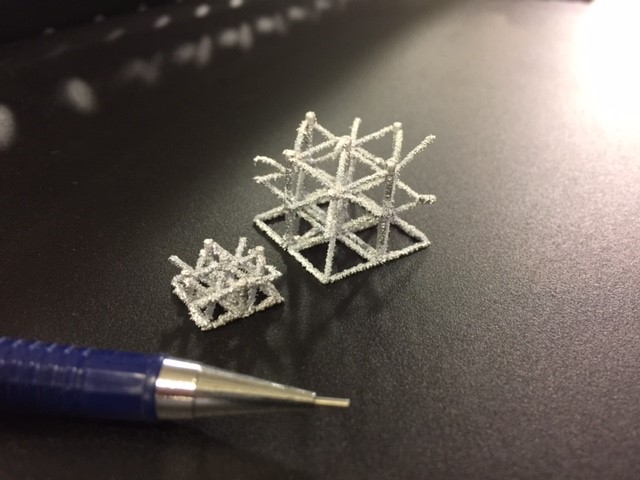Metal AM continues to become more widespread across a variety of industries, but the high price point of materials is still a limiting factor in its adoption. It can cost up to $1 million to fill a machine with enough powder to produce some of the larger aerospace parts using powder bed fusion (PBF), not to mention the health and safety concerns that result in working with tiny metal particles.

Back in 2013 father and son Scott and Zach Vader viewed these limitations as an opportunity to advance metal additive manufacturing and developed an alternative process, Magnetohydrodynamic (MHD) printing. Acquired by Xerox in February 2019, Vader Systems’ technology uses wire feedstock in lieu of powder. Gravity feeds the molten metal from a tiny crucible into a nozzle and, using the same physics that make a motor turn, it jets individual molten metal droplets on demand, creating dense metallic parts.
Material efficiency
The wire feedstock used in MHD can be as little as one fifth the cost of similar metal in powder form, making the process more cost effective and accessible for a variety of applications and industries. It is not just about saving material costs, however, MHD also allows for greater control and geometric freedom in the production of parts by customising drop size, placement and spacing.
Using its drop by drop method, MHD can produce engineered lattice structures without the need for support materials – by overlapping the metal droplets to create an in-built diagonal support system. This helps create more complex structures without the need to remove supports in post production, helping to save time and costs. Geometric complexity can be achieved more easily and more cost effectively than traditional methods like die casting and even PBF, making MHD ideal for lightweighting in industries like automotive and aerospace.
Scaling up
As I mentioned earlier, the cost of producing large scale parts for these industries can be crippling using PBF, due to the amount of powder needed to fill larger machines. While we’re still testing the upper and lower limits of nozzle sizes and their effectiveness, in theory, MHD may be better suited to create economically viable larger parts than PBF since there is no need to fill large tanks with expensive metal powders.
The very nature of the MHD process also means that there is less wasted material. There is no leftover powder to try to remove from complex structures and there is no need to recycle unused powder. This also eliminates the need to maintain traceability of mixed lots of recycled powder in aerospace and biomedical industries.
MHD is not set to replace PBF when it comes to metal AM, however. Currently it is most suitable for aluminium and zinc alloys, as well as for aluminium alloys that are traditionally considered ‘unweldable’. The next step up is copper, but additional engineering is needed to design jetting assemblies that handle higher temperatures. Once this is tackled, it won’t be too huge a leap to steel and nickel alloys.
Harder and more expensive materials, the likes of Titanium alloys are PBF’s sweet spot and will likely continue to be. A much bigger leap would need to be made for these to work with MHD, as it would require different engineering approaches to the heating and cooling processes.
Printed electronics
Functional printing is the holy grail of AM research and, much like our colleages at the University of Nottingham, we are doing a lot of work and testing in this area. Circuit patterns with silver or copper inks can prove very expensive and the adhesion of these with polymers has proven to be a challenge, producing limited conductivity at best.
Based on these learnings, we have experimented with using MHD to print aluminium circuit board patterns onto flexible plastic substrates and, so far, it has worked quite well. We haven’t experienced any drop off in conductivity and there is good adhesion to the plastic. Not to mention the wire feedstock is two orders of magnitude less expensive than silver nanoparticle inks, which could be a real game-changer in advancing printed electronics from research into industrial applications.
There is still a long way to go, but suffice to say we are eagerly awaiting the kinks to be worked out for copper wire feedstock to test the production of circuit boards.
Room for both
As a professor and researcher, it is my job to push the boundaries of technology and get excited about all the possibilities it can offer. MHD is one of these technologies, but by no means the only effective one. Advances are being made to make the most of PBF and there is plenty of room for further innovation in metal (and functional) AM. The good news is with the development of more cost effective methods and companies like Xerox investing in its growth, metal AM is becoming a more viable manufacturing method.
Denis Comier - Earl W. Brinkman Professor of Industrial and Systems Engineering at Rochester Institute of Technology
To learn more about MHD and see it in action, visit this year’s Additive International Conference, which takes place at the Nottingham Belfry on 10th- 11th July. Register here: https://www.additiveinternational.com/










Water Sector Talent Exodus Could Cripple The Sector
My local water company is Severn Trent which has a market capitalisation of £8.2 billion, made a pre-tax profit of £200 million in 2024 and is paying...